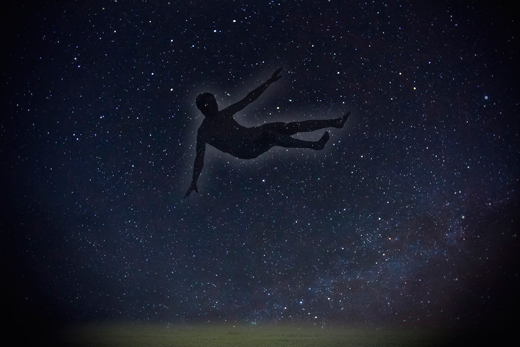Theater Emory and the Emory Dance Program premiere their first collaboration, "Free/Fall: Explorations of Inner and Outer Space," on April 3 in the Mary Gray Munroe Theater.
Under the leadership of director Janice Akers, along with choreographers and Dance Program faculty Lori Teague and George Staib, a company of 16 professional and student actors, dancers and writers take on the notion of why we take risks and sometimes follow what might be perceived as reckless impulses.
The performance investigates our ever-expanding universe through meditations on human nature, relationships, flight and how very much like the forces of the cosmos we can be.
Performances of "Free Fall: Explorations of Inner and Outer Space" will be April 3 – 5 and April 9 – 12 at 7 p.m., and April 6 and 13 at 2 p.m.
Tickets are $20 general admission, $16 discount category members, $6 Emory students, and are available through the Arts at Emory box office by calling 404-727-5050 or visiting www.arts.emory.edu.
Akers sat down to discuss the collaborative process behind this original work:
At the outset of this project, you started with inspiration and research, but essentially zero script. How have you gone about generating material and a structure for this piece? Is the task of creating a show from the ground up a daunting one?
More exciting than daunting, I would say. It presents its own set of challenges. We knew from the beginning that two things were important about "Free/Fall": that the ensemble of performers would have the experience of contributing some text to the project and that we were looking for a place for both theater and dance to land, a topic that could accommodate both movement and text. I think we found that in the idea of the cosmos.
Our text is really a compilation of anecdotes, quotes, factual information, and some original writing by myself and others. The "script" includes movement pieces as well, because movement is integral because the cosmos is in constant motion and flux.
Your cast includes a diverse ensemble of professionals, students, alums, actors, and dancers. Has the task of bringing them together been challenging? Why did you want such a diverse company?
Well… it's the cosmos! We were striving for an ensemble that could capture the dynamic energies of the solar system in voice and body. We wanted the performers to be from varied backgrounds, multi-generational with different approaches to performance and expression.
What is it about the cosmos as subject matter that works so well for a dance/theater collaboration?
When astronomers talk about the cosmos, you often hear words or phrases that describe behaviors, moods, relationships, even arcs and journeys and sudden eruptions of "emotion."
The language also has highly physical imagery: rotation, orbiting, colliding, intersecting, floating, coming towards, flying away.
What do you hope will come out of this collaboration with the Emory Dance Program? Do you see more projects like this in Theater Emory's future?
"Free/Fall" is the realization of a longtime goal, which was to produce a major performance project with Theater Emory and the Emory Dance Program. The dance program here is admired for its innovation, challenging work, and artistic excellence.
The choreographers and composer discuss interpreting "Free/Fall"
What excites your most about this project?
Lori Teague, choreographer: What excites me is the act of transforming my usual way of working as a choreographer to collaborate with artists from diverse disciplines. I am equally excited about the ideas that can be explored in the cosmos.
With this project, I am given a fresh entry point, a chance to research movement as I am researching the cosmos. More than anything, this project excites my love of entering an environment with unpredictable consequences.
George Staib, choreographer: This project, for me, represents a unique way to enter source material that is not only stimulating, but brings to the surface profound sensations and overwhelming thoughts about the subject matter.
The process has been literal shots in the dark – opportunities to experiment, chances to see just how big or small something can be, while still holding weight.
As for music, how do you interpret a broad concept like the cosmos to compose a soundscape for live performance?
Kendall Simpson, composer: The starting point is that there are psychological and emotional associations that all of us have when we hear certain sounds but there is no literal meaning when a note of music is played. In taking on the cosmos, I have a distinct advantage in creating a soundscape that is not restricted by preconceived concepts or meaning.
Normally, such a large blank canvas is paralyzing for me, but when each of us is seeking direction or feedback, we look no further than the people in the rehearsal room [cast and directors] to help us craft the scene.

